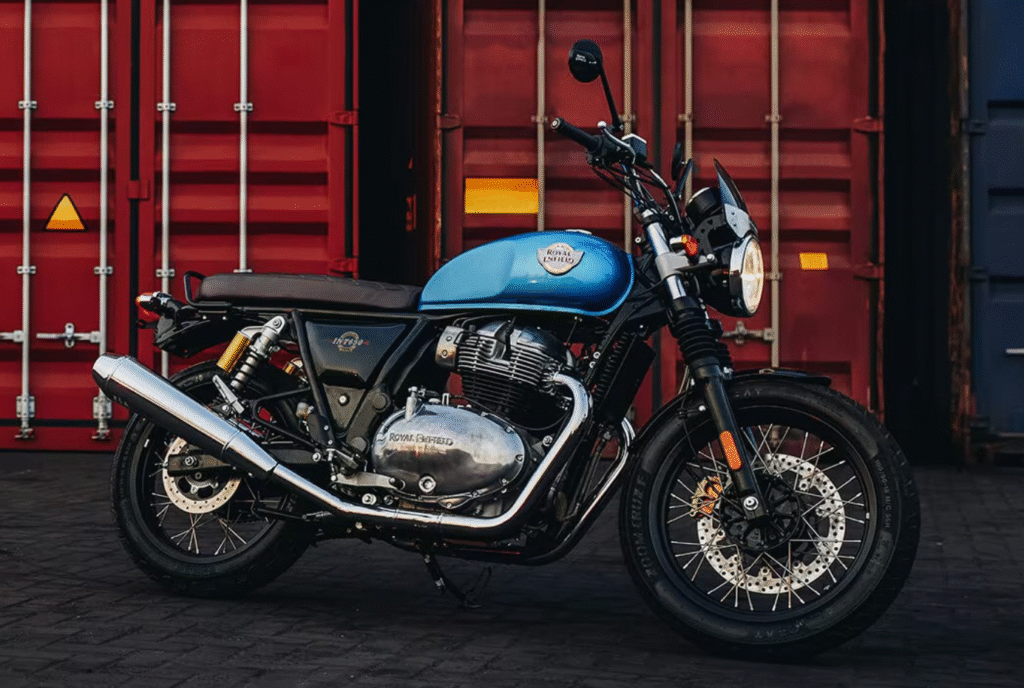Engine and Performance
The Interceptor’s 648cc air-cooled parallel twin is its heart and soul. It makes about 47 horsepower and 52 Nm of torque, all at an easy pace. In everyday riding this means smooth, usable power – it pulls strongly from low revs so you don’t have to rev it hard to go. On the highway it cruises comfortably at 70–80 mph without straining. Once warm, the engine vibrates very little, giving a mellow character. It’s not a high-strung sportbike engine, but that steady punch perfectly suits the bike’s vintage vibe. Even after heavy use, the motor feels strong and reliable, delivering that old-school exhaust note and steady rhythm we rode it in with.
Retro Charm and Comfort
Two years on, the Interceptor’s styling hasn’t aged a bit. It still turns heads with its teardrop tank, bright chrome tank badges, and twin analog gauges. The wide, cushy seat is comfortable for long solo rides, and the upright riding position means no strain on the wrists or back. Handling-wise it’s relaxed – the suspension soaks up bumps on highways and city streets, and the bike leans predictably in corners at moderate speeds. As a cruiser it rewards a relaxed pace. The small passenger pad can work for short hops but isn’t ideal for long-distance two-up touring (as expected on this style of bike). Overall, it remains a great choice for someone who values classic looks and a comfortable ride over high-tech gadgetry.
Reliability and Maintenance
After 24 months (including cold winters and highway commutes), our Interceptor has been impressively reliable. We’ve only done routine service: oil changes, valve clearances at 6,000-mile intervals, and regular chain lubrication. The engine starts without fail every time, and apart from normal wear items (tires, chain, brake pads) nothing major has broken. Its simple air-cooled design means no radiators or complex electronics to go wrong. We did replace one tiny electrical relay under warranty in the first year, but otherwise we’ve needed zero unplanned repairs. It truly runs like a clockwork, and that durability has only given us more confidence in the bike.
Features and Technology
By modern standards the Interceptor is pretty basic, but that’s part of its charm. The instrument cluster is classic: two analog dials (speedo and tach) plus a small digital insert for odometer, trip meters, and clock – there’s no fuel gauge or gear indicator. Braking is handled by a 320mm front disc and 240mm rear disc, both with dual-channel ABS for safety. All the lighting (headlamp, taillight, turn signals) has been updated to LED for better visibility. Other than that, it’s old-school. There are no riding modes, no traction control – just a pure throttle-and-twist experience. For many riders that simple, mechanical feel perfectly matches the bike’s vintage vibe.
Price and Value
When new, the Interceptor 650 had an MSRP around $6,149 in the U.S. That’s excellent value for a twin-cylinder bike with this much character. Even now, two years later, it holds most of its value thanks to Royal Enfield’s loyal fanbase. Compared to other 650cc cruisers or retro bikes, it remains very affordable. Maintenance costs are low too, thanks to the simple engine and readily available parts. We did add a few light accessories (a small windshield and crash guards), but the stock bike already delivered everything we needed for daily riding and light touring. In short, it gives you a lot of bike for the money.
In summary, our two years with the Interceptor 650 have been extremely positive. It continues to run flawlessly, and the joy of its classic style hasn’t worn off. In fact, it feels even more dependable and user-friendly now than it did new – a true workhorse with soul. For anyone drawn to laid-back, retro motorcycling, this Royal Enfield remains a standout choice even after years of use. Classic riding doesn’t get much better or simpler than this.




